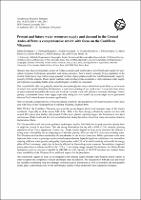Present and future water resources supply and demand in the Central Andes of Peru: a comprehensive review with focus on the Cordillera Vilcanota
Metadata
Show full item recordAuthor(s)
Date
2014Collections
- Congreso [32]
Related Resource(s)
https://meetingorganizer.copernicus.org/EGU2014/EGU2014-13194.pdfAbstract
Glaciers have been an important element of Andean societies and livelihoods as direct freshwater supply for agriculture irrigation, hydropower generation and mining activities. Peru’s mainly remotely living population in the Central Andes has to cope with a strong seasonal variation of precipitations and river runoff interannually superimposed by El Niño impacts. Direct glacier and lake water discharge thus constitute a vital continuous water supply and represent a regulating buffer as far as hydrological variability is concerned. This crucial buffer effect is gradually altered by accelerated glacier retreat which leads most likely to an increase of annual river runoff variability. Furthermore, a near-future crossing of the ‘peak water’ is expected, from where on prior enhanced streamflow decreases and levels out towards a new still unknown minimum discharge. Consequently, a sustainable future water supply especially during low-level runoff dry season might not be guaranteed whereas Peru’s water demand increases significantly.
The following license files are associated with this item:








